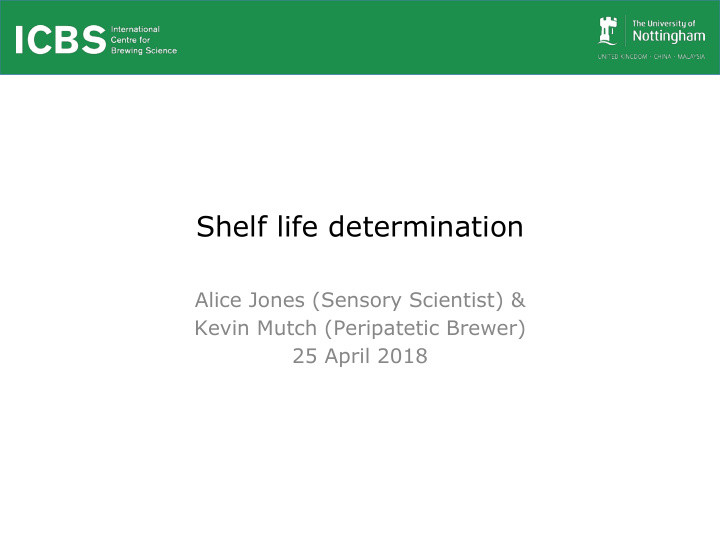



Shelf life determination Alice Jones (Sensory Scientist) & Kevin Mutch (Peripatetic Brewer) 25 April 2018
Topics • How • Product stability • Customer perception • Stale beer flavours • Tasting panel & tests • Sensory training • Product tasting schedule
How do you determine shelf life? • Guess/NI • Nellie • Contract packager • OBs • Scientific method – Tasting panel – Tasting throughout packaged life • Tasting – test types • Record keeping
Shelf Life aka Product Stability • Product starts to deteriorate from package date • BBD or Fill Date • Perceived to be inherently resistant to infection by pathogenic bacteria • Many cases beer beyond its best by BBD • BBDs set by time beer will not develop turbidity • Artificially set for logistics constraints • Depends on package type
Forms of Product Instability • Microbial spoilage susceptibility • Light sensitivity • Propensity to gushing • Colloidal (haze, non-biological) – polished = quality? • Flavour – stale – wet cardboard/paper – time consumed
Customer Perception • Many consumers may not recognize the flavour of stale beer • Do recognise the normal flavour of their favourite beers - usually the flavours of fresh beer • As beer ages develops new flavours - fresh flavours diminish • Most staling due to oxygen
Flavours Associated With Stale Beers • Cardboard, sherry, and/or blackcurrant • Caramel on pale beers • Darker colour (pilsners) • Haze &/or ppts • Aldehydes • Sweet, bready, toffee, and wine-like (Maillard reaction) • Lightstruck • Heavily hopped (bright, floral, citrus to tea-like)
Tasting Panel & Tests • Paired comparison – Directional difference – determines particular attribute variation between two beer (> or < sweet) requires training – Preference – determines preference between two beers in consumer test & must be untrained panel • Triangle Test – Three samples (x, x, & y) – pick out Y
Final Beer Testing • Product profiling – standard or trial products – changes in raw materials, yeast strain, process changes (time, temps, O 2 levels) • QC - samples from warehouse • QA - samples from trade
Sensory Training • Flavour profiling/training – Aroxa – https://www.aroxa.com/beer/beer-flavour- standard – FlavorActiV – https://www.flavoractiv.com/flavour- standards/reference-standards/index.html#beer • Positive release / hold procedure
In-process Tasting Schedule: Every brew, every vessel, every day Daily Tasting: Date: Brewing raw materials Scoring: 1 Good 2 Saleable 3 Poor Gyle Agg. Score Comments Tasters Malt Head Bwr Malt Op 1 Malt Op 2 Cold Liquor Office 1 Hot Liquor Office 2 HL + treatments Guest 1 First Runnings Guest 1 Sweet Wort Hopped Wort Pitched Wort From Tank Scoring: 1 Good 2 Saleable 3 Poor Gyle Agg. Score Comments Tasters FV1 Head Bwr FV 2 Op 1 FV 3 Op 2 FV 4 Office 1 FV 5 Office 2 CT 1 Guest 1 CT 2 Guest 1 BBT 1 BBT 2
Packaged Products Tasting Schedule Daily Tasting: Date: Finished Products Scoring: 1 Good 2 Saleable 3 Poor Product (C, K, 5, 7, M) Gyle Agg. Score Comments Tasters Head Bwr Op 1 Op 2 Office 1 Office 2 Guest 1 Guest 1 Release to Authority Product (C, K, 5, 7, M) Gyle Comments trade? to release HB/GM Cask Package +1, Package +7, Package +14, Package +28, Packgage BBD+1 Keg Package +1, Package +7, Package +14, Package +28, Packgage BBD+1 Can Package +1, , Package +28, Packgage BBD+1 Bottle (Bright) Package +1, , Package +28, Packgage BBD+1 Bottle (Bttl. Condit) Package +1, Package +7, Package +14, Package +28, Packgage BBD+1 Bulk (out) Package +1, Contracted (in) Receipt +1, Receipt +7, Receipt +28, Receipt +90, Receipt+180, (Receipt + 270), BBD+1
Recommend
More recommend